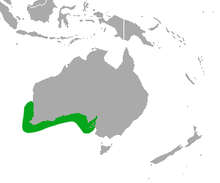Neophoca cinerea
| Australian sea lion | |
|---|---|
 |
|
| A family of Australian sea lions at Seal Bay Conservation Park, Kangaroo Island, South Australia | |
| Scientific classification | |
| Kingdom: | Animalia |
| Phylum: | Chordata |
| Class: | Mammalia |
| Order: | Carnivora |
| Suborder: | Pinnipedia |
| Family: | Otariidae |
| Subfamily: | Otariinae |
| Genus: | Neophoca |
| Species: | N. cinerea |
| Binomial name | |
|
Neophoca cinerea (Péron, 1816) |
|
 |
|
| Australian sea lion range | |
The Australian sea lion (Neophoca cinerea) also known as the Australian sea-lion or Australian sealion, is a species of sea lion that is the only endemic pinniped in Australia. It is currently monotypic in the genus Neophoca, with the extinct Pleistocene New Zealand sea lion Neophoca palatina the only known congener. These sea lions are sparsely distributed through Houtman Arbrolhos Islands (28°S., 114°E.) in Western Australia and The Pages Islands (35°46’S., 138°18’E) in Southern Australia. With a population estimated at around 14,730 animals, the Wildlife Conservation Act of Western Australia (1950) has listed them as “in need of special protection”. Their Conservation status is listed as endangered. These pinnipeds are specifically known for their abnormal breeding cycles, which are varied between 5 months breeding cycle and a 17-18 month aseasonal breeding cycle, compared to other pinnipeds which fit into a 12-month reproductive cycle.
The Australian sea lion is a pinniped, most closely related to other species of sea lions and fur seals making up the family Otariidae. These mammals use their flippers to propel themselves in water and can walk on land with their flippers. Australian sea lions share distinct features with other sea lions. These include short fur, short flippers and a bulky body.
In pinnipeds, mothers and pups are frequently separated throughout nursing and are thus expected to have evolved an efficient individual recognition system. Consequentially, in Australian sea lions, as in many social mammals, mothers and their offspring can identify each other. Individual recognition produces mutual benefits by avoiding misdirected maternal care and therefore energy expenditure for mothers, and the risk of injury for young approaching unrelated, potentially dangerous, adult females. Individual recognition can be accomplished with a combination of several sensory modalities, including olfaction, vision, and audition. The use of olfactory cues as a close range recognition mechanism allows mothers to further confirm their pup’s identity. In contrast to recent olfactory studies in pinnipeds which showed the presence but not a natural function of olfaction in pinnipeds, the present study shows that wild Australian sea lions use their olfactory abilities in a functional manner, by discrimination between the scents of their own offspring and a non-filial pup. However, in a dynamic, crowded colony, the acoustic channel seems to be the most reliable modality. For pinnipeds, neither visual nor olfactory cues are likely to be the primary modality for mother–pup recognition.
...
Wikipedia

